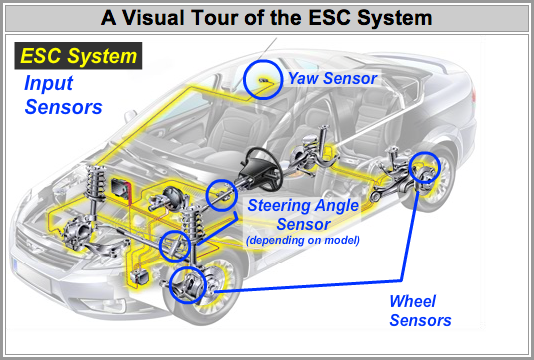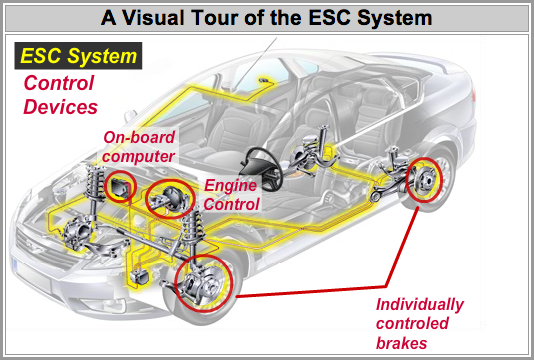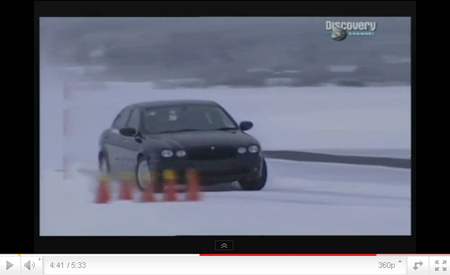crash-avoidance systems (ESC)
are required on all new cars, light trucks, and SUVs
What is ESC? Imagine a computer system in your vehicle that monitors how the driver is trying to control the vehicle and then takes over in an emergency; like if your tires slip during cornering or if the vehicle is about to spin out or maybe when the steering doesn’t respond quickly enough to avoid

ESC is so effective that vehicle accident fatalities were reduced by more than 25% over a five year period. Estimates are that ESC helps avoid 600,000 accidents every year and reduces vehicle roll-overs by 75%. But ESC isn’t new. It was optional equipment in the late 90’s and then grew to being standard equipment on more than 50% of vehicles sold during 2007. ESC and crash avoidance systems actually began with the development of antilock brakes and then traction control. ESC was created by the addition of a Yaw sensor and a computer capable of making more decisions and then sending commands to the brakes and other critical control systems.
Vehicle safety systems continue to improve with additional sensory inputs like proximity sensors and cameras that alert both the driver and the computer. Understanding how your vehicle is equipped and maintaining the vehicle’s traction capabilities (Steering, suspension, shocks, struts, brakes and tires) is critical to the performance of crash avoidance systems.
You can read a full explanation below, or watch this video demonstration from the Discovery Channel.
- Wheel sensors, which monitor speed, direction and rotation.
- Lateral and longitudinal acceleration sensors, which monitors the vehicle’s speed and direction.
- A steering angle sensor, which monitors the driver’s intended direction.
- A yaw sensor, which monitors the vehicle for symptoms of a skid (also known as “spinning out of control”).

 Control devices: ABS, Traction Control, and ESC all control the vehicle by modulating brakes on individual wheels in precise amounts. Unlike the others, ESC also has the ability to modulate the throttle (engine speed) and transmission.
Control devices: ABS, Traction Control, and ESC all control the vehicle by modulating brakes on individual wheels in precise amounts. Unlike the others, ESC also has the ability to modulate the throttle (engine speed) and transmission.- Individually controlled brakes.
- Throttle (engine speed) control.
- Transmission control (on some models).
- ABS (Anti-lock Braking System) is designed to eliminate the tires from locking up or skidding during heavy braking. This helps keep traction and improves maneuverability.
- Traction Control is designed to keep the tires from spinning during acceleration, like on wet or icy conditions. This helps traction during acceleration.
- The effectiveness of ESC is limited by the ability of the tires and the vehicle’s suspension. If the tires can’t grip the road, then it’s just like driving on ice and therefore, it’s important to have good tires and ride control components that aren’t worn.
- Replacement parts (like shocks and struts) must be calibrated to perform within the vehicle’s design. Some aftermarket parts (especially low cost/low quality parts) are not as capable. These parts will affect the performance of ESC and may cause brakes to apply when you don’t want them to.
While the electronic components of your ESC system won’t wear like tires, shocks, struts, or brakes; they should be inspected on a regular basis. Check your Owner’s Manual for a schedule provided by the manufacturer.
Wearable parts like the brakes, shocks, struts, and tires all require regular maintenance and periodic replacement. Automotive experts agree: We suggest replacing OE shocks and struts after 50,000 miles (80,000 kilometers).
Brake and tire wear rates vary, so ask your local Certified Ride Control Specialist to inspect them and other components that affect ESC. With proper maintenance, you can be sure that ESC will continue to keep your vehicle operating as it was designed.
